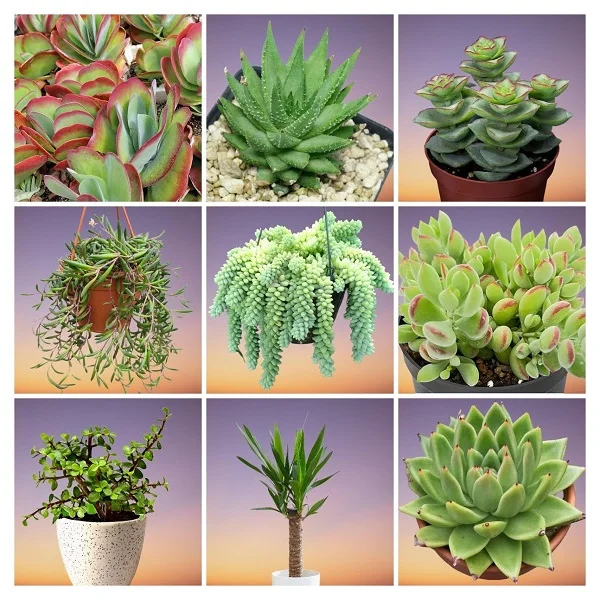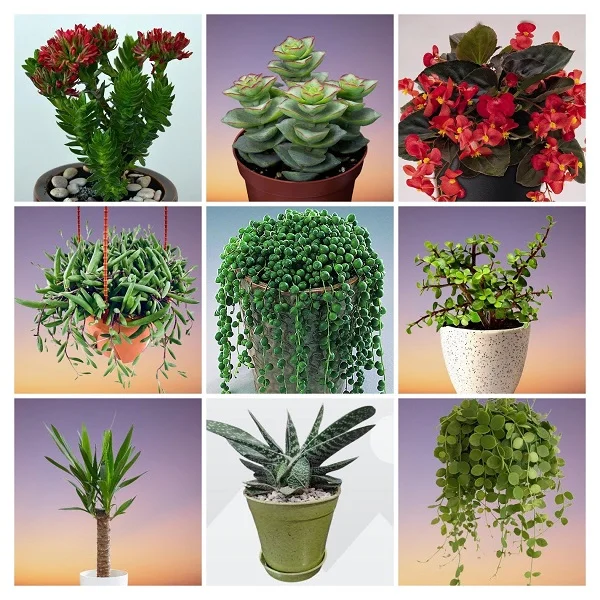Desert Cacti Indoor Care and Propagation Guide for Beginners
Some links in this post may be affiliate links
Desert Cactus thrive in bright light to full sunlight with at least 2-3 hours of sunshine per day, average warmth and humidity, and moderately moist, well drained soil coupled with monthly feeding in spring and summer.
Desert Cactus come in numerous forms and sizes and they form interesting plants which are especially popular with beginners as they can tolerate some level of neglect.
They have many adaptations for water conservation. The native habitat of Desert Cactus is subject to drought; many live in extremely dry environments like the Atacama Desert. They are among the popular drought-tolerant plants grown in the home.
Desert Cactuses are some of the common succulents plants and bear thickened, fleshy parts adapted to store water. Most species have lost true leaves, retaining only spines, which are modified leaves.
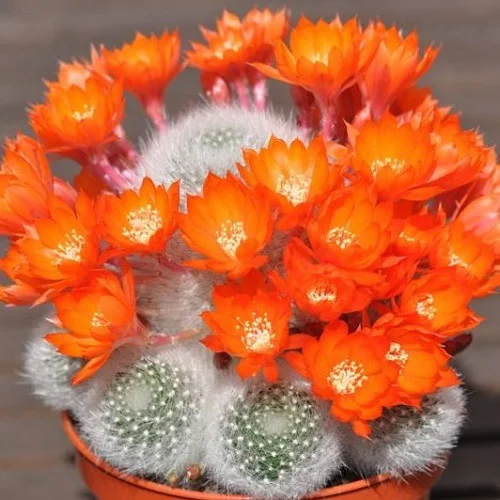
Rebutia spp
The spines are produced from specialized structures called areoles; woolly or hairy areas on stems. Areoles are the identifying feature of cacti. The areoles also give rise to flowers.
These Cacti have shallow root system that quickly absorb any water reaching the soil surface. Their stems are ribbed or fluted which allows them to expand and contract easily for quick absorption of water.
The leafless, spiny stems are succulent which is an adaptation to store water. The surface of the stem may be smooth or covered with protuberances of various kinds, usually called tubercles.
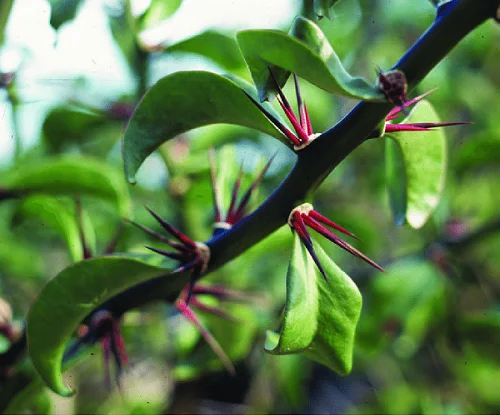
Pereskia spp (Rose Cactus)
One odd one of the Desert Cacti is Pereskia spp (above) which bears thin stems and true leaves. The flowers look like wild roses and hence the common name Rose Cactus. It grows to a height of 6 feet.
Most Desert Cacti employ the CAM (Crassulacean Acid Metabolism). CAM plants are plants that harvest Carbon dioxide at night and use it during the day to make their food.
As they make their food they store the oxygen they produce in the process and release it at night. This is an adaptation of CAM plants to their drought-prone climate which enables then survive the harsh climate. Desert Cacti require plenty of sunlight, free-draining, sandy soil and to be kept on the drier side.
Another group of Cacti are the Forest Cacti which are native to the tropical rain forests. Forest Cacti are so different in form and requirements from the Desert Cacti. Popular Forest Cacti are Christmas Cactus, Easter Cactus and Orchid Cactus. Take a look at these 21 types of Cactus Plants that are perfect for growing in the home.
Are Desert Cacti toxic?
No. Desert Cacti are considered non-toxic to humans and pets. However, some have spines and thorns, though they are not poisonous it is advisable to wear gloves while handling to avoid injury.
How to Care for a Desert Cactus Indoors
To care for a Desert Cactus indoors, provide bright light to full sunlight with at least 2-3 hours of sunshine per day, warmth of 16-280C, humidity of 50-55% and moderately moist, fast-draining potting soil coupled with monthly feeding in spring and summer.
Young Desert Cacti require repotting annually during the growing season while mature plants are repotted when pot-bound. Keep reading for more on these growth conditions and how to provide them.
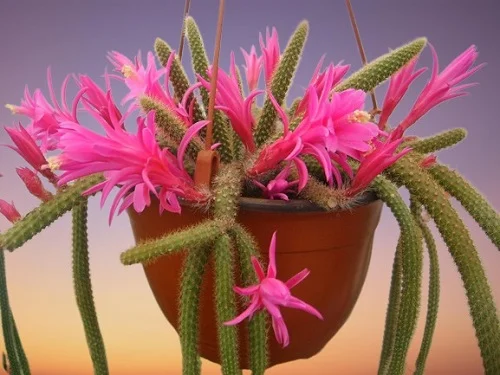
Aprocactus spp
Light Requirements
Do Desert Cacti need sunlight?
Yes. Desert Cacti grow best in bright light to full sunlight with at least 2-3 hours of morning or late afternoon sunshine per day. Avoid exposing it to too hot sunlight before acclimating it as it can get sun scorched.
If the light is too low the plant will grow elongated stems in an attempt to reach the light source. Where the natural light is not sufficient, you may use full spectrum grow lights to supplement it.
Rotate the pot a quarter turn every few days to ensure that the plant receives light from all sides for even growth.
Watering
How often should you water a Desert Cactus?
Water Desert Cactus liberally in spring and summer while allowing the top 2-3 inches of soil to dry out between waterings. Keep the soil moderately moist and take care not to overwater to prevent rotting and death of the plant.
Lessen watering in fall and winter to maintain the soil barely moist as growth is slowed at this time. Do not let the soil dry out completely to avoid shrivelling and wrinkling of leaves.
Avoiding wetting the foliage as it can lead to rotting; you may water from the bottom instead. Use room temperature water to avoid cold shock which can result in stunted growth.
Ensure that the pot has a drainage hole and that the soil is well-drain to prevent waterlogging as it can result in rotting and loss of the plant.
Temperature & Humidity
Desert Cactus prefer a warmth of 16-280C. Keep them away from cold drafts to avoid reduced growth and eventual death of the plant.
Desert Cacti flourish in a humidity of 50-55%; they have no need for extra humidity. Maintain good air circulation to prevent fungal diseases infestations.
Fertilizer
Feed Desert Cactus monthly in spring and summer with a phosphorous (for root development) and potassium (to enhance flowering) rich fertilizer. Do not feed in the dormancy stage (fall and winter) to prevent fertilizer burn as growth is minimal at this time.
Potting Soil
The best soil for Desert Cactus should be coarse, low in organic matter and one that drains fast to prevent it from holding excess water. The soil should be loose enough to allow water to drain out quickly. Most Cactus and succulents mixes are ideal for these plants.
Repotting
Repot the young Desert Cactus annually during the growing season (spring and summer). Repot mature plants only when extremely pot-bound as they thrive when slightly root-bound.
Use a shallow rather than a deep pot as they have shallow roots. Be careful not to bury the stems of to prevent rotting.
Select a pot 1 size larger than the current one to avoid overpotting. Make sure that the pot has a drainage hole and the soil is fast-draining to avoid sogginess which can lead to rotting. Take a look at these succulents pots on Amazon.
Desert Cactus Propagation
Desert Cactus is propagated at the beginning of the growing season from offsets which form at the base of the plant or stem cuttings.
1. Propagating Desert Cactus from offsets
- Seperate the offsets from the mother plant and allow it to dry (callus) for 1-3 days before potting.
- Fill small pots one thirdway with a well-draining soil. Use pots with drainage holes to prevent rotting.
- Position the offset in the center of pot and cover the roots with the soil while being careful not to bury the stems to prevent rotting.
- Place the pots in a warm, well-lit place away from direct sunlight to prevent scorching.
- Water sparingly; only when the soil is dry and avoid waterlogging to prevent rotting.
- Once well established, move the new plant to its display position and begin routine care.
2. Propagating Desert Cactus from stem cuttings
- Take a 3-4 inches stem cutting from a healthy plant and allow the stem cuttings to dry (callus) for 1-3 days.
- Fill a small pot with succulents potting mix and make a hole in the center. Ensure that the hole is slightly wider than the base of the stem cutting.
- Insert 2-3 inches of the lower cut-end of the cuttings in the previously made hole and lightly firm the soil around the stem cutting while taking care not to bury it too deep.
- Place the set up in a warm, well-lit spot away from direct sunlight.
- Maintain the soil moist by light misting until the new plant is well established after which you can begin routine care.
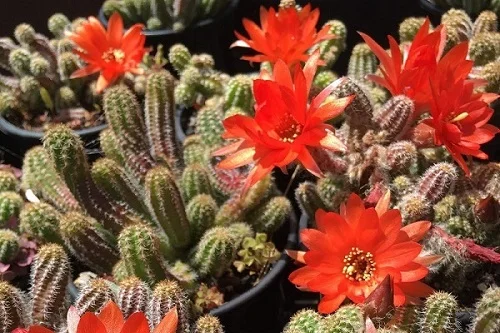
Chamaecereus silvestrii
Desert Cactus Problems & Remedies
Desert Cactus common problems are leggy growth, stunted growth, corky patches, pests and diseases among others. Keep reading for more on these problems and how to fix them.
Leggy growth
Leggy growth on Desert Cactus which is represented by elongated stems is caused by too little light.
How to fix it
Too little light: Position the Cactus in a brightly-lit spot where it will receive bright light with some direct sunlight or instal a grow light where the natural light is not enough.
Stunted growth
Lack of growth in Desert Cactus is due to inconsistent watering, soggy soil, insufficient light, drafts or pest infestations.
How to fix it
Inconsistent watering: Water when the top 2-3 inches of soil dry out but do not allow the soil to dry out completely.
Soggy soil: Use fast-draining and a pot that has a drainage hole.
Insufficient light: Move the plant to a brighter spot where it will receive bright light with some direct sunlight or instal a grow light.
Drafts: Keep the Cactus away from sources of drafts like windy doors and windows, AC units, heat sources among others.
Pest infestations: Regularly inspect the plant for these pests and carry out timely control measures.
Corky patches on the surface
Corky patches on the surface of Desert Cactus are due to underwatering, physical injury or cold drafts.
How to fix it
Underwatering: Water when the top 2-3 inches of soil dry out and never allow the soil to dry out completely for a prolonged period.
Physical injury: Keep the plant away from the line of traffic.
Cold drafts: Keep the plant away from cold drafts emanating from windy doors, drafty wndows and others.
Pests
Common pests on Desert Cacti are mealybugs, scale insects and spider mites which are prevalent in stuffy, dry air conditions.
How to fix it
- Isolate the affected plant to prevent spread to other plants.
- Treat the plant with a horticultural oil as per the manufacturer's recommendations.
- Regularly check underneath and between the leaves for these pests and carry out timely control measures.
- Maintain a good air circulation to depress the pests infestations.
Diseases
Desert Cactus are prone to the following diseases:
1. Crown and stem-rot disease which presents as brown soft patches, shrivelled stem-tips and soft rot below. It is common in overwet conditions coupled with poor air circulation.
How to fix it
- Discard the affected plant as it will not recover.
- Avoid wetting the foliage during water: water from the bottom instead.
- Improve ventilation for good air circulation to minimize this fungal disease.
- Use a pot with a drainage hole and well-draining soil to prevent sogginess.
2. Root-rot disease which is prevalent in overwet soil conditions due to poor drainage. It is characterized by a rotting base, yellowing and browning followed by stem collapse.
How to fix it
- Carefully slip the plant out of its pot and inspect the roots; brown-black mushy roots indicate root-rot.
- Trim the rotten roots and treat the healthy roots with a copper-based fungicidal solution as indicated by the manufacturer.
- Repot the plant in fresh, fast-draining soil and a pot that has a drainage hole.
- Place the plant in bright light and stop watering for a few days to give the plant enough time to recover.
You liked it? Share on social media.
Related Content
Amazon Associates Disclosure
Homeplantsguide.com is a participant in the Amazon Services LLC Associates Program, an affiliate advertising program designed to provide a means for sites to earn advertising fees by advertising and linking to amazon.com.



